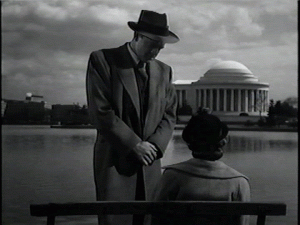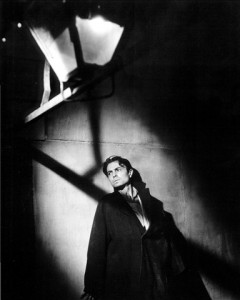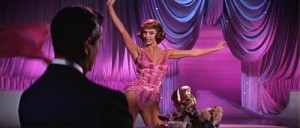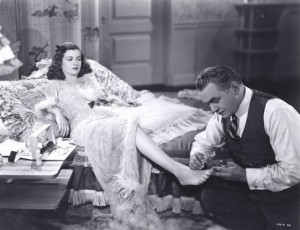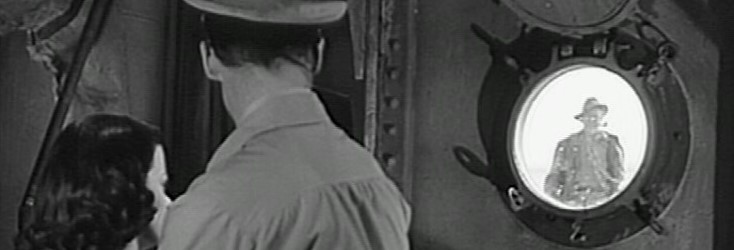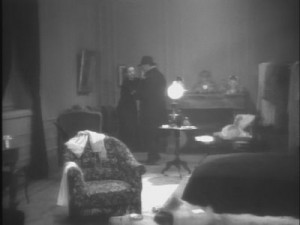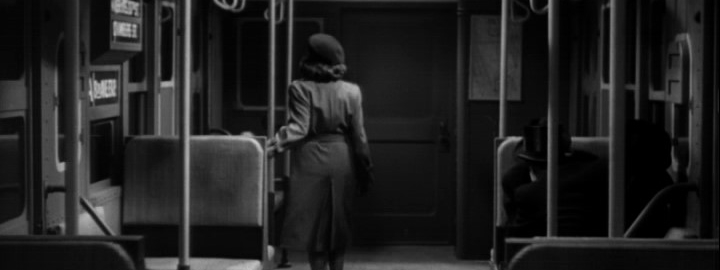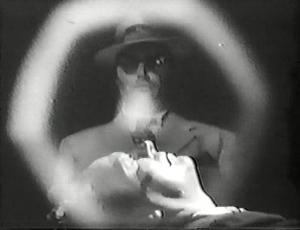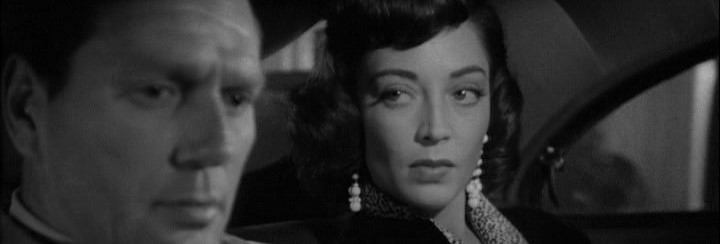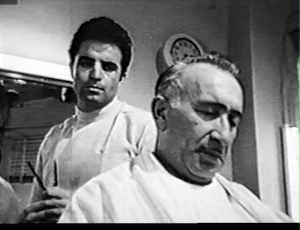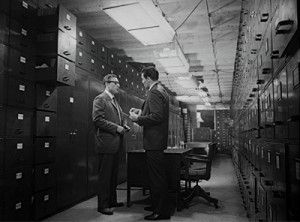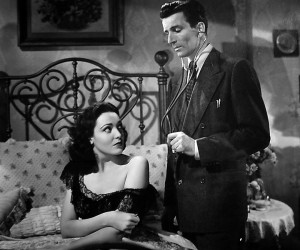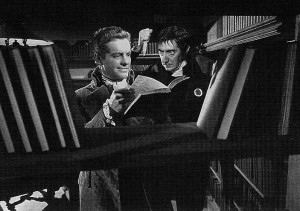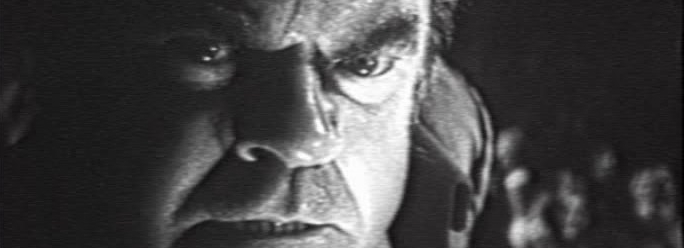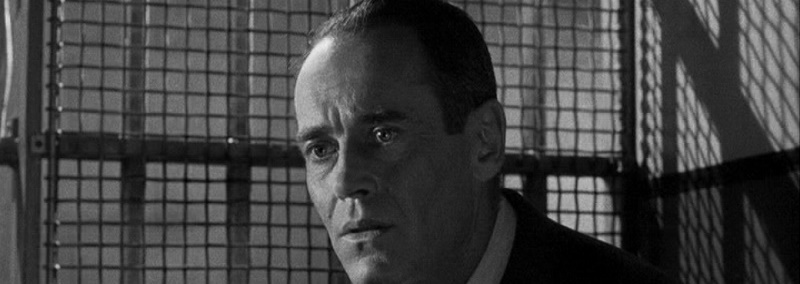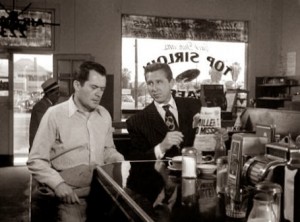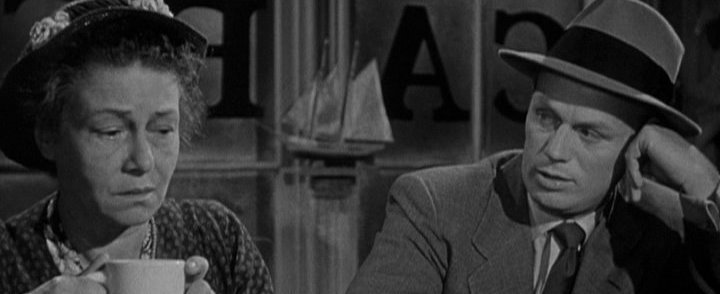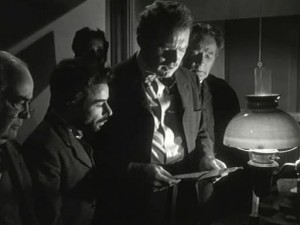Published by DVD Beaver in April 2006. I’ve updated this to include further links for films that have subsequently become available; there are in fact quite a few of these, and, unless I’ve missed something, only one title that isn’t currently available, The Argyle Secrets. — J.R.
Most of my favorite offbeat musicals are commercially available on DVD, and I wrote about them for DVDBeaver in March. I can’t say the same about most of my favorite noirs, and I’m not sure why this is so.
It’s also important to stress that “noir” isn’t a genre; it’s a category that’s applied retroactively to films with certain traits in common — a practice started by French critics and eventually continued by us Yanks and others. (Check out James Naremore’s definitive 1998 book on the subject, More Than Night: Film Noir in its Contexts.) This makes it something more flexible than a genre, and I’ve tried to honor this factor in some of my choices.
In the following list I’ve managed to make peace with myself by appending one SBA title (which stands for “should be available”) to each one that you can currently buy, in the same general category, with brief explanations added. (In fact, many of my SBA titles can be found in pirated DVD-Rs by determined web surfers, though not always in decent copies. Let’s hope that this fact might spur the various copyright holders of these films into finally bringing them out in better editions.)
There are many favorites that for one reason or another I’ve regretfully had to omit. (Most often, this is because they’re already well enough known not to need my recommendation.) Here’s a short list, complete with categories: Anticommunist Noir: My Son John; Art Movie Noir: Odd Man Out, The Night of the Hunter, The Manchurian Candidate, Point Blank, The Long Goodbye; Closet Gay Noir: Gilda; Deep South Noir: The Phenix City Story (with documentary prologue), Heist Noir: The Killing, Jean-Pierre Melville’s Second Breath; John Cassavetes Noir: The Killing of a Chinese Bookie; Marilyn Monroe Noir: Don’t Bother to Knock; New York Noir: Sweet Smell of Success; Nicholas Ray Noir: In a Lonely Place, Party Girl. And now on to the list proper:
Capitalist Corruption Noir:
Force of Evil (1948). If we consider how the Hollywood Blacklist cheated us out of great films and brilliant careers that might otherwise have existed, it’s hard to think of a worse casualty than writer-director Abraham Polonsky (1910-1999), whose first feature —- provoked by the script he wrote for another strong John Garfield film, Body and Soul, in 1947 — is almost surely the greatest debut in the history of noir. “Might talkies be like the opera?” Polonsky once asked. “The main thing is the music but O the joy when the singers act and the songs are poetry….I assumed for Force of Evil that the three elements, visual image, actor, word, are equals….All I tried to do was use the succession of visual images, the appearance of human personality in the actors, and the rhythm of words in unison or counterpoint.” The results, played out in the anguished love between a crooked New York lawyer (Garfield) and his honest brother (Thomas Gomez), is a tragedy of uncommon force. And then Polonsky couldn’t direct another feature for 21 years.
Billy Wilder’s corrosive and unrelenting 1951 attack on cynical journalism, Ace in the Hole, memorably pairing Kirk Douglas and Jan Sterling in New Mexico. (It was such a box office flop that the studio re-titled it The Big Carnival, which didn’t help.)
Fritz Lang Noir:
Scarlet Street (1945). The most savage melodrama in Lang’s career — worthy of Erich von Stroheim in the intensity of its passion and treachery about a prostitute (Joan Bennett) and her pimp (Dan Duryea) bamboozling an aging cashier and painter Edward G. Robinson) — is actually a remake of La chienne (1931), the first sound film of Stroheim’s greatest disciple, Jean Renoir (see Jean Renoir Noir, below). But for all the power of the original, what Lang does with the story is so creepy and chilling that it may give you nightmares. And the recent re-mastering of archival materials of this classic on Kino Video, after years of blotchy public domain versions, is top-notch.
While the City Sleeps (1956) — the closest Lang ever came to remaking his greatest film, M — concentrates more on jaded big-city journalists exploiting the moves of a serial rapist-killer and his victims than on the criminal himself, offering a withering look at Eisenhower America.
Jean Renoir Noir:
Woman on the Beach (1947). Renoir’s Hollywood swan song is a haunted, perverse nightmare that practically begins with a surrealist dream. A shell-shocked Coast Guard veteran (Robert Ryan) becomes drawn towards a slutty femme fatale (Joan Bennett again) who blinded her painter husband during a drunken brawl and now feels chained to him; the blind husband (Charles Bickford), no sweetie-pie either, insists on befriending the vet. The abrupt, splintered narrative runs so contrary to the simple-minded humanism that many critics expect of Renoir that this film’s often passed over in embarrassed silence, or else written off as an erotic melodrama eviscerated by the censors and then largely re-shot after a bad preview. But Renoir scholar Janet Bergstrom suggestively argues that the imposed changes may have actually improved the film by reordering and condensing its obsessions into a kind of dreamlike abstraction. (If a film can be said to have an unconscious, this one certainly speaks its mind.)
Renoir’s second talkie, La Nuit du carrefour (1932) — my all-time favorite French noir, and the sexiest movie he ever made — has never even been subtitled [2015: until recently — see link.] But his edgy adaptation of Georges Simenon’s Maigret at the Crossroads, filmed in a foggy suburb that vibrates with off-screen sounds and a mysterious Danish heroine (Winna Winifried), cries out for discovery.
Low-budget Noir:
The Seventh Victim (1943). Producer Val Lewton has misleadingly been called a master of horror when in fact he mainly made cheap, noirish art movies that were marketed as horror items. The first three, justly celebrated (and sometimes genuinely scary), were directed by the great Jacques Tourneur —- Cat People (1942), I Walked with a Zombie (1943) The Leopard Man (1943) —- but the greatest and most densely plotted of them, directed by Mark Robson, came right after these. Packing an inordinate number of vivid characters into 71 minutes —- including a lonely girl looking for her lost sister, a resurrection of the shrink from Cat People, a couple of lesbian characters, a detective, a lawyer, and a poet —- this doom-ridden tale about a cult of devil worshipers in Greenwich Village has a moment that anticipates the shower murder in Psycho, and an overall feeling for desolate city streets at night that was virtually Lewton’s signature.
SBA: The still cheaper The Argyle Secrets (1948) — by another talented and subsequently blacklisted writer-director, Cy Endfield (see Pessimistic Noir, below), who had to move to England in 1953 to continue working. This grade-Z crime thriller is even shorter (at 63 minutes), more action-packed, and crammed with bizarre visual flourishes, such as a dripping faucet to represent a dying man’s final gasps.
Minimalist Noir:
The Narrow Margin (1952). The recently deceased Richard Fleischer (1916-2006) staged his best noir thriller — about a police detective (Charles McGraw) escorting a gangster’s moll (Mary Windsor) from Chicago to Los Angeles so she can testify against the mob — inside a few tight train compartments while various assassins try to find her and bump her off. The wisecracks in Earl Felton’s salty dialogue come fast and hard, and the plot is full of unexpected developments in these confined spaces.
Irving Lerner’s Murder by Contract (1958), written by Ben Simcoe and an uncredited Ben Maddow — which might be subtitled “Zen and the Art of Being a Hitman” as illustrated by Vince Edwards. Long before Quentin Tarantino was a gleam in anyone’s eye, and around the time that Ghost Dog’s Jim Jarmusch was pushing five, this work of terse black humor set down many of the basics of these filmmakers’ separate geometries in outlining the criminal mind.
Orson Welles Noir:
The Lady from Shanghai (1947). All that survives today is about half of Welles’s rough cut of his last Hollywood “A” picture, made for Columbia —- a baroque thriller in which he costars with his ex-wife Rita Hayworth, playing a leftwing Irish sailor who gets taken up by a crooked, crippled lawyer (Everett Sloane), his glamorous wife (Hayworth), and the lawyer’s eccentric partner (Glenn Anders doing a creepy impersonation of Nelson Rockefeller). What remains is fragmented and confusing at times, but it’s still my favorite of Welles’s noirs. (I’m not counting Citizen Kane.)
The first two release versions of Touch of Evil (1958), my second favorite. I was a consultant on the third version — a re-edit by Walter Murch based on a memo written by Welles to Universal in the 50s — and it was never the intention of Murch, me, or our producer Rick Schmidlin to replace the film’s original release version or the longer preview version that supplanted it in the 70s. We were hoping that all three could be released in a DVD box set. Universal, are you listening? [2015: Apparently they were.]
Otto Preminger Noir:
Angel Face (1952). Preminger was one of the great noir specialists when he was working at Fox, and the recently released Laura (1944), Whirlpool (1949), and Where the Sidewalk Ends (1950) are three key examples. But my favorite Preminger pictures are the 1959 Anatomy of a Murder (not really a noir) and his RKO loan-out Angel Face, sleek and shocking, costarring Jean Simmons in the title role and Robert Mitchum. She’s a spoiled and murderous heiress with a father fixation (in some ways this is Preminger’s first draft of his 1958 Bonjour Tristesse) and he’s an ambulance driver who becomes the family chauffeur and her lover. Sexy and poetic.
SBA: The 13th Letter (1951). Another Preminger noir made at Fox, his first film partially shot on locations (in Quebec). It’s a remake of Henri-Georges Clouzot’s paranoid Le corbeau, my second favorite French noir, made during the German occupation (1943), about anonymous poison-pen letters tearing apart a small town. Even after removing the original period context, Preminger makes it creepy on his own terms.
Period Noir:
Anthony Mann’s The Black Book (1949). One of the great unacknowledged forms of noir is costume drama. I can’t think of a better example than this campy, hugely enjoyable thriller about the French Revolution —- also known as Reign of Terror, with Robert Cummings, Richard Basehart, and Arlene Dahl — brilliantly shot by John Alton, the greatest noir cinematographer. I even prefer it to Mann’s more conventional noirs in contemporary settings, many of them also shot by Alton. Furthermore, the version of this gem currently available is priced so low that it’s an uncommon bargain.
James Whale’s The Great Garrick (1937). On second thought, this hilarious romp about French and English ham actors in the 18th century may be a still better example, even if it doesn’t look quite as good. David Garrick (Briane Aherne) publicly insults the acting abilities of the Comédie Française, so members of this acting company take over a roadside inn, playing locals in order to fool him — but he’s secretly aware of the scam. The results are as modernist and as hilarious as Renoir’s The Golden Coach.
Pessimistic Noir:
Alfred Hitchcock’s The Wrong Man (1956). One of the most depressing Hollywood movies ever made, meticulously based on a true story, about a bass player at Manhattan’s Stork Club (Henry Fonda) who gets wrongly fingered for a crime and then locked up, causing his wife (Vera Miles) to go mad. Uncharacteristically shot by Hitchcock on location, as if it were a documentary, this prompted the best piece of film criticism that Jean-Luc Godard ever wrote, and led Godard to call Hitchcock, in his Histoire(s) du Cinéma, “The only one apart from [Carl] Dreyer who knew how to film miracles.”
SBA: Cy Endfield’s The Sound of Fury (1950). Even more pessimistic is Endfield’s best American movie — a brilliant assault on journalistic corruption mated with everyday economic desperation that ends with the most terrifying depiction of a lynching that exists on film. Like Ace in the Hole (see above), which offered a comparable critique of American journalism, the negativity is so intense that this tanked at the box office and was subsequently re-titled, but the second title (Try and Get Me) didn’t help.
Samuel Fuller Noir:
Pickup on South Street (1953). This doesn’t really deserve to be cross-referenced with Anticommunist Noir, as if often is, because Fuller’s use of Communist heavies is strictly generic and fairly typical of the period. (Believe it or not, Fuller was a liberal around this time who supported Adlai Stevenson.) His real interest is in the street-smart Manhattan low-lifes like a pickpocket (Richard Widmark) and a police informer (Thelma Ritter in her best performance) and the kind of marginal existence they have. (Widmark’s Skip lives in an abandoned shack on the docks and uses the river as his refrigerator; Ritter’s Moe sells ties.)
Park Row (1952). Fuller’s favorite among his own pictures — another period noir, this one about the birth of New York tabloid journalism in the 1880s. Fuller, who grew up in the aftermath of this milieu and worked as a copy boy on Park Row, financed this movie himself and lost every penny, building a full-size replica of the street and casting his favorite lead, Gene Evans, as a cigar-chomping editor. This is corny and hyperbolic, bursting with energy in the best Fuller manner. My favorite line: “The day you learn how to read, you’re fired.”

